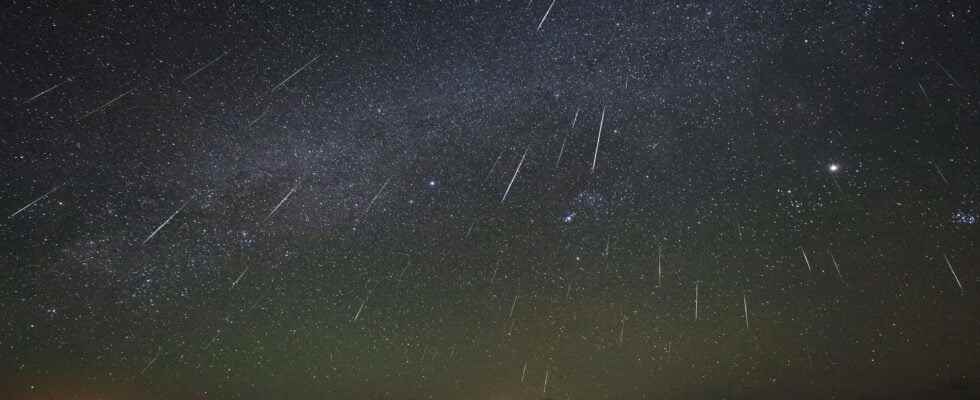The year has barely started when an intense meteor shower is going to spray the sky this evening. The Quadrantides is one of the most beautiful of the year.
You will also be interested
[EN VIDÉO] Amazing shooting stars seen from space Here’s an unusual take on shooting stars: Watch as they enter Earth’s atmosphere from space, aboard the International Space Station (ISS).
The year 2022 begins with a bang in the field of celestial spectacles, because this Monday, January 3 – in addition to the perihelion of comet Leonard (the 2021 comet photos are a treat) -, the peak of activity of the Quadrantids occurs. This very strange name corresponds to the first, and one of the most beautiful,shooting Stars of the year.
The activity of this meteorite swarm which starts every year around December 28 is announced to peak this evening around 8:40 p.m. UT, i.e. around 9:40 p.m. Paris time. The average hourly rate is about sixty visible meteors with, in the precipitation, a few racing cars spectacular (larger pieces). Of course, this is still a forecast, which means the show can get more intense a bit later that night.
the radiant of the Quadrantids is located in the missing constellation of Quadrans Muralis – ephemeral constellation imagined in 1795 by theastronomer French Jérôme Lalande -, who occupied an area between the Bouvier, Hercules, the Dragon and the tail of the Big bear. It is in this direction that you must therefore turn to surprise this evening as much as possible of this debris entering theatmosphere earthly. By virtue of its position, European observers at high latitudes are the most privileged.
A rain of shooting stars with mysterious origins
The great meteor shower of the Quadrantids was first observed two centuries ago, in 1825. Astronomers have traced them back to the 2003 object EH1, a asteroid with unusual behavior which could in reality be an extinct comet, as the origin of this very fine current of dust that the Earth crosses each year. This January 3, we cut the most dense part of the flow, which corresponds to the peak of activity. Its duration is relatively short (6 hours), warn specialists, in particular because of the narrowness of the current at the point of intersection with theorbit terrestrial and also because of its almost perpendicular inclination.
As with every observation of the starry sky, it is essential to flee the light pollution, therefore the cities and all urban agglomerations in order to make the most of this beautiful spectacle. There won’t be such beautiful ones for several weeks. Luck this year is that the Moon will not be there to disturb us.
If you go outside tonight to watch the Quadrantids, you won’t be able to sparkle Venus aligned with Saturn and Jupiter.
Watch the Quadrantid meteor shower on January 3
Article by Xavier Demeersman published on January 2, 2017
The year has just started and there is already an important meteor shower not to be missed. The Quadrantids, that’s their name, can be seen on the night of Tuesday January 3 to Wednesday January 4, in a northeastern direction and from the disappeared constellation of the Mural Quadrant, located between the Dragon, the handle of the Great Casserole and the Bouvier.
Like every year, it is the Quadrantids that start the ball rolling with meteorite swarms. Active between December 28 and January 10, this swarm is unfairly less famous than the Perseids summer and other Leonids or Geminids which take place during thefall. However, it is not one of the least. Indeed, the average hourly rate of 20 to 50 meteors visible during this period can suddenly climb to 120 for a few hours during the peak of activity. It is neither more nor less than the first major rain ofshooting Stars of the year. After this, it will be necessary to wait April and the Lyrides to see another as abundant.
For 2017, the maximum activity is expected for Tuesday, January 3 at around 2 p.m. UT (3 p.m. Paris time) according to specialists. Even though the Quadrantids are exclusively visible in thenorthern hemisphere, it seems, alas, that Europe is less well placed than western North America. In any case a priori, because the peak of activity can very well be shifted by a few hours and finally occur during the night of January 3 to 4. Anyway, to hope to observe some, it will be necessary to stay on the lookout, especially in the second part of the night, when the radiant rises.
A radiant located in a missing constellation
The small specks of dust from this swarm pass through our atmosphere at a speed average of 42 km / s. The star-parent has been identified as 2003 EH1. This is a asteroid – probably an extinct comet – with an estimated size of between 3 and 4 km. Her orbital period is 5 and a half years old.
The Quadrantids, or Quads for short, are so named relative to the region of the sky where the radiant is located, in this case the old constellation of the Wall Quadrant (Quadrans Muralis). This one, created in 1795 by the Frenchman Jérôme Lalande, in honor of the astronomical instrument he used a lot, has gradually faded into oblivion. It occupied a place between the Big Dipper (Ursa major), also known as the Grande Casserole, the Bouvier (Bootes), Hercules (Hercules) and the Dragon (Draco), all heading north, northeast.
As always, to make the most of a meteor shower, it is advisable to settle in a site where the light pollution is as low as possible. Needless to say, you have to cover yourself well and be comfortably sitting or lying down.
Interested in what you just read?
.
fs3
